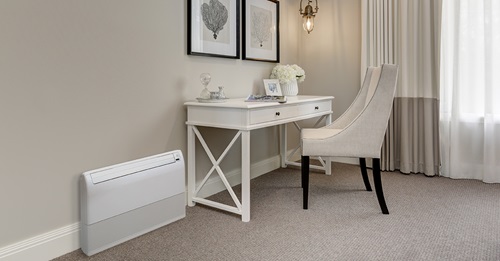Your Complete Guide to Buying an Air Conditioner

It’s estimated that Australians will spend around $3.1 billion¹ cooling their homes this summer, and with the average electricity price now 37% higher than last year, it makes choosing the right air conditioning system more important than ever. If the goal is to keep your home comfortable without driving up energy costs, it helps to know how to use your air conditioner efficiently and select the right unit for your space.
Running the right air conditioner settings and modes is one of the easiest ways to cut down on energy use. Selecting a moderate temperature (around 25–27°C), using energy-saving options like Eco Mode or Sleep Mode and setting timers (so your unit doesn’t run all day) can all make a huge difference. These simple adjustments help your system work efficiently, reduce strain and keep your home cool and comfortable without leading to excessive electricity bills.
Of course, purchasing the right system in the first place is just as important. With so many models, sizes and features available, buying an air conditioner can feel overwhelming. To make the process simple, we’ve put together this air conditioner buying guide to help you select the ideal air conditioning solution for your home. Whether you’re upgrading or buying for the first time, you’ll learn how to get year-round comfort while keeping your energy bills under control.
Why Planning Your Air Conditioner Purchase Matters
An air conditioner isn’t something you replace every year; it’s a long-term investment in your home’s comfort, so you want to make the smartest choice. An AC buying guide helps you plan so you can pick a system that’s the right size, has the features you need and saves energy long-term.
By carefully matching the unit to your home, you can avoid the mistake of choosing one that struggles to cool effectively or one that’s oversized and inefficient.
Types of Air Conditioners Explained
When buying an air conditioner, it helps to understand the different types available and how they suit various home layouts and needs. The main options are:
Single Room Air Conditioners – Ideal for smaller spaces such as bedrooms, home offices or smaller living spaces, these units are designed to cool or heat one room at a time. Available in wall mounted, floor console or cassette styles, they’re economical, simple to install and worth the money if you want climate control only in central areas.
Multi Systems – A flexible solution that allows several indoor units to connect to one outdoor system. This setup is perfect for homes that need efficient cooling and heating across multiple rooms without several bulky outdoor units.
Ducted Air Conditioning – Suited for air conditioning an entire house, ducted systems blow air using concealed ductwork, allowing you to cool or heat several rooms at once. With zoned options made possible, you can choose which areas of the home to cool for maximum efficiency.
AC Purchase Guide: Key Things to Consider
Before you decide on the right system, it’s necessary to look beyond the brand or model and think about how it will work in your home. An air conditioner buying guide helps you compare the features that matter most, from efficiency to installation, so you can make a confident choice. Size, placement and usage habits also affect comfort and operating costs. The following sections break down the essentials so you know exactly how to buy an air conditioner that suits your lifestyle.
Know your Space
Prior to speaking to an air conditioning specialist, it’s a good idea to be aware of the features and layout of your home. This includes knowing the number and size of your rooms, the direction the building is facing and whether there is insulation. This will save you time and money. The specialist can then give you the best advice for what air conditioning unit is suited to your requirements, such as:
the size and power of the unit
the type, whether it’s a split system, multi system or ducted air conditioning system
should it be reverse cycle (heating and cooling) or cooling only for people living in warmer parts of Australia.
Why is this essential? Installing a unit that is the wrong size can increase your energy usage. A system that’s too small will constantly struggle to cool the space, while one that’s too large may short-cycle and fail to create the comfortable environment you want.
Lifestyle also plays a role when considering an air conditioner selection guide. Think about when you’ll use the system most often. Many units include programmable timers, so you can schedule operation only when needed. For instance, if no one is home during the day, there’s no need for the unit to run until you arrive home in the evening.
To ascertain the right size, our Air Conditioner Room Size Guide has all the tips you need.
Request a Heat Load Assessment
A heat load assessment is a key part of the quoting process carried out by an air conditioning specialist to work out how much heating or cooling your home needs. It takes into account things like:
The size of the rooms (square metres and ceiling height)
Insulation levels in walls, floors and ceilings
Window type and orientation (e.g., double-glazed, facing direct sun)
Local climate and average temperatures
How many people and appliances are in the space (since both produce heat)
The result tells the specialist the required capacity (in kW) the air conditioner should have to efficiently heat or cool the space. They’ll then make a recommendation so you get the most efficient performance and long-term comfort.
If you’re ready to take the next step, find a stockist to discuss your requirements and arrange a professional heat load assessment for your home.
Stamp of Approval
When comparing air conditioners, it’s worth looking at brands that have been recognised by both consumers and industry bodies. Awards and acknowledgements give you confidence that a unit delivers on performance, reliability and customer satisfaction.
Fujitsu General has been recognised multiple times for trust, quality and value. Australian customers have chosen us as the Most Trusted Air Conditioning Brands in the Reader’s Digest Awards for five consecutive years (2018-2022) and received Highly Commended from 2023-2025.
In addition, Fujitsu earned Australia’s Most Loved Air Conditioning Brand (2024) and Top Value Air Conditioner Brand (2024) in Finder’s Customer Satisfaction Awards, based on a nationwide survey of over 10,000 consumers.
These awards demonstrate our ongoing commitment to delivering efficient, reliable and trusted comfort solutions for Australian homes.
Energy Star Ratings
One of the easiest ways to judge efficiency is by looking at the Energy Star rating for heating and cooling modes. The higher the star rating, the more efficiently the system will perform. This makes it simple to compare models in any AC unit buying guide and find the best fit for both your budget and household needs.
Fujitsu General’s Lifestyle range of reverse cycle wall mounted units features improved star ratings across heating and cooling, making them an excellent choice for energy-conscious homes. To better understand how these ratings work, check the zoned energy rating labels, which provide clear details on performance across Australia’s different climate zones.
Installation by a Professional
In addition to choosing the right air conditioning system for your home, it’s crucial to have it installed by a professional. Having a trained refrigerant and air conditioner professional ensures that your system is set up correctly from the start, helping to avoid issues such as incorrectly fitted piping. Poor installation can lead to refrigerant leaks, which are difficult to detect as refrigerant is an odourless gas and must only be handled by qualified technicians.
Fujitsu’s Authorised Partners can provide you with a unit and installation price quote. This way, you can be sure that your system is in qualified hands.
Demo Run
After installation, the installer will provide a demonstration to show you how to correctly use the air conditioning unit and controller. This will help you understand the optimal temperature settings, how to set up timers to cool or heat the home when required and how to change reverse cycle units from cooling to heating mode when the seasons change.
Feature List
Operating an air conditioning unit that is more than 10 years old can contribute to higher energy usage. Newer models are more technologically advanced and efficient, and may include new energy management features such as Human Sensor control, economy mode and weekly timers. These features can help to reduce costs as your air conditioner will only be on as needed, therefore making it more efficient for keeping you cool all summer and warm all winter. Speak to your installer to understand the specific features that your unit has.
The Lifestyle range of reverse cycle air conditioning systems is one of Fujitsu’s most efficient, helping to manage energy consumption while providing year-round comfort and control in the home.
It’s important to consider all factors that may affect what is the best solution for your home. By seeking professional advice and being prepared with your requirements, it will make the selection and installation process easier and save you time and money in the long run.
When is the Best Time to Buy an Air Conditioner?
Buying an air conditioner outside of summer, especially in the shoulder seasons like spring or autumn, usually means lower demand. This can make it easier to shop around and compare models, take advantage of better deals and schedule your installation without long wait times.
Professional Advice and Next Steps
Choosing the right air conditioner is a big decision, and seeking professional guidance makes all the difference. From selecting the right system for your home to ensuring it’s installed and serviced correctly, Fujitsu General provides expert support at every step. With award-winning products and a nationwide network of trusted partners, you can rely on Fujitsu to deliver comfort, efficiency and long-term value.
If you’re looking to buy an air conditioner or need tailored advice for your home, contact us today. Our team is committed to helping you stay comfortable at home, no matter the season.
__________________________________
¹ https://www.finder.com.au/energy/aircon-statistics


.tmb-tmb420.jpg?sfvrsn=5c4be2e1_1)


